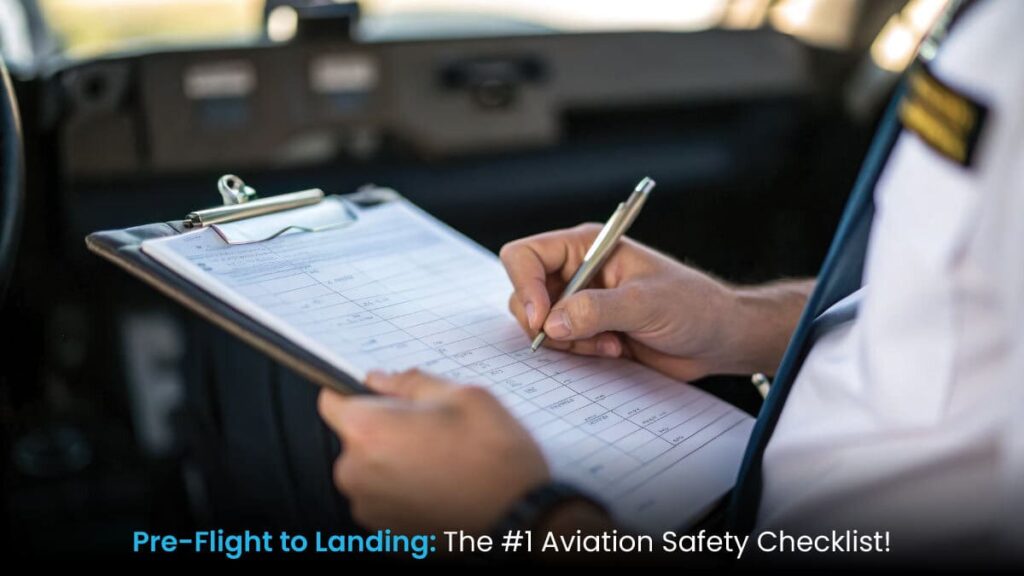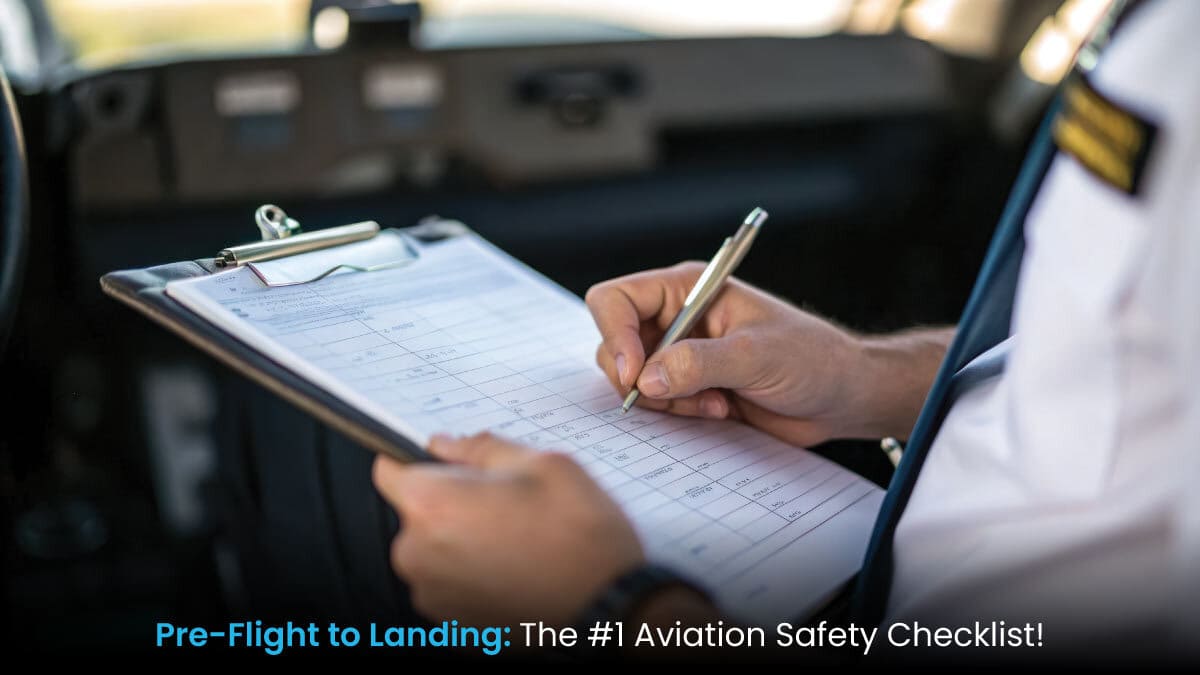
Why Checklists Matter in Flying
Flying may look exciting from the outside, but behind every smooth flight is a sharp, prepared pilot. And that preparation starts with one thing: a checklist.
Getting ready for travel works as an excellent analogy. It would be unacceptable to pack without vital items such as a phone charger and toothbrush. Aircraft pilots bear risks that exceed those of any other flight crew. Disregarding a single step from the checklist such as fuel checks and warning light monitoring, may cause critical flight complications. Insight Aviation pilots follow training that requires them to treat their checklists as their most reliable flight partner.
Checklists aren’t just paperwork. They’re part of a mindset. They build habits, focus, and safety discipline—exactly what the DGCA expects from future captains of Indian skies.
Pre-Flight Prep: Where Safety Begins
Before anyone hits the throttle, a pilot needs to walk the talk—literally. That means inspecting the aircraft, confirming paperwork, and reviewing the weather.
Here’s a simplified version of what happens before you even sit in the cockpit:
Quick Pre-Flight Walkthrough:
- Documents Check: License, logbook, aircraft registration, insurance—everything should be current and onboard.
- Walkaround Inspection: Walk around the plane. Look for dents, loose panels, or leaks.
- Fuel & Oil: Make sure fuel is enough, uncontaminated, and the oil level is good.
- Flight Controls & Surfaces: Move them gently. They should respond smoothly.
- Tires & Brakes: Flat or worn tires? Brake fluid leaks? Fix before flight.
- Lights Test: Navigation, landing, beacon—all need to work.
Next comes your route planning:
- Weather Briefing: Check METARs and TAFs, yes, but don’t ignore local airfield alerts.
- Weight & Balance: The aircraft shouldn’t be overloaded. Period.
At Insight Aviation, cadets are trained to slow down and focus. If anything feels off—even a small noise—it’s worth checking again. Rushing this phase is never worth it.
Cockpit Systems Check: The First Layer of Flight Safety
Now you’re strapped in and ready to start the engine—but not so fast. Your pre-takeoff checklist is about to begin.
This is where the cockpit comes alive, and every switch, dial, and reading has a role to play.
Essential System Checks:
- Avionics Setup: Radios, transponder, GPS—all should be configured properly.
- Engine Gauges: Look for normal oil pressure, temps, and RPMs after startup.
- Battery & Electrical: Monitor voltage. Backup battery, if any, should show healthy status.
- Flight Instruments: Check altimeter settings, compass calibration, and speed indicators.
- Flaps & Trim Settings: Set for takeoff per your aircraft’s POH.
- Final Light Check: One last sweep of all external/internal lighting.
- Redundancy Check: Ensure backups like standby altimeters or secondary radios are operational.
Cadets at Insight also simulate issues like electrical failures or stuck trim tabs—because real-world flying demands mental agility. These drills sharpen judgment and help cadets stay composed under pressure.
In the Air: Awareness Never Sleeps
Once airborne, you might think the hard part’s over. But flying safely means constant attention. Systems, weather, position—all need regular checks.
Here’s what good in-flight monitoring looks like:
- Gauge Scan: Oil temp, RPMs, airspeed, altimeter—get into a rhythm of scanning every few minutes.
- Stay Ahead of the Aircraft: Plan your altitude and route adjustments before ATC asks.
- Engine Sounds: Any unusual noise? That’s a red flag.
- Weather Changes: Look for clouds building up or shifting winds.
- Fuel Flow: Are you burning more fuel than expected? Cross-check with time and distance.
- Diversion Plans: Always have a Plan B airstrip in mind.
Cadets are trained to avoid “automation complacency.” Just because the autopilot is on, doesn’t mean your brain is off.
Takeoff and Landing: The Critical Moments
Takeoff and landing are like bookends—short, intense, and make-or-break. Most aviation incidents happen during these windows, so they get special attention in training.
Before Takeoff Checklist:
- Run-Up Tests: Throttle up to test magnetos, mixture, and engine response.
- Control Surfaces: Do a final check—elevator, rudder, ailerons.
- Canopy/Doors: Locked tight.
- Trim & Flaps: Set per takeoff configuration.
- Radio Set: Tower or ground frequency locked in.
- Abort Plan: Know when and how you’ll abort if needed.
Before Landing Checklist:
- ATIS & Winds: Get airport info and wind direction.
- Approach Briefing: Know your pattern entry and missed approach plan.
- Gear & Flaps: Configure as you descend.
- Landing Lights: On.
- Stable Approach: Manage power, pitch, and descent rate.
Insight Aviation cadets rehearse takeoffs and landings in many conditions—nighttime, gusty winds, short strips—so when it’s real, they’re ready.
Flight Simulators: The Ultimate Training Ground
Before a cadet flies solo, they log hours in a flight simulator—a cockpit replica that mirrors real-world flying.
Here’s why simulators are key for aviation safety systems training:
- Engine Failure After Takeoff: What do you do when you lose power at 200 feet?
- Radio Failure: Learn to squawk 7600 and follow NORDO rules.
- Power Management: Simulate total electrical failure.
- Alternate Navigation: When GPS is out, fly VOR or dead reckoning.
- Diversions & Emergencies: Handle runway closures, weather pop-ups, or bird strikes.
These aren’t just drills—they’re memory-building tools. When emergencies happen in real life, muscle memory kicks in. That’s why Insight’s sim sessions are treated as seriously as actual flights.
Wrap-Up: Building a Pilot Mindset
Together with mindset goes the proper skills to execute flying tasks effectively. Every flight begins with proper checklist respect, which forms the foundation of the flight safety mindset.
At Insight Aviation, cadets are trained to treat every flight—real or simulated—with the same discipline. They’re not just learning to pass a checkride. They’re learning to lead a safe, professional cockpit.
You might be a cadet today, but tomorrow, you’ll be responsible for lives at 30,000 feet. Let every checklist you follow now be a step toward that future.
FAQ’s
Q: What is an aviation safety checklist?
A: It’s a step-by-step list pilots follow to make sure the aircraft is safe before, during, and after a flight.
Q: Why is a checklist important in aviation?
A: It helps pilots avoid mistakes, follow safety rules, and handle the aircraft correctly in all situations.
Q: What does a typical checklist include?
A: It includes checks for pre-flight, engine start, take-off, landing, shutdown, and emergency procedures.
Q: Where can I get the full checklist?
A: Your flying school or aircraft manufacturer provides the checklist. You can also find it in the aircraft’s Pilot Operating Handbook (POH).
Q: Are there different checklists for commercial and private pilots?
A: Yes, checklists vary based on the aircraft type and license level (PPL, CPL, etc.), but the basics stay the same.
Q: Can this checklist help with flight exams or checkrides?
A: Absolutely! Following the checklist properly is a key part of passing your DGCA checkride.
Q: Is there a checklist for emergency procedures too?
A: Yes, every aircraft has a separate section for emergency checklists—like engine failure, fire, or electrical issues.

